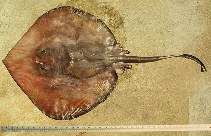| Family: |
Plesiobatidae (Deepwater stingrays) |
| Max. size: |
270 cm TL (male/unsexed) |
| Environment: |
bathydemersal; marine; depth range 44 - 780 m |
| Distribution: |
Indo-Pacific: South Africa, Mozambique, southern India, east to the Philippines (Ref. 5281), north to Japan and south to Australia. Also reported from the Hawaiian Islands. |
| Diagnosis: |
Dorsal spines (total): 0-0; Dorsal soft rays (total): 0-0. A giant plain stingray with a broadly pointed snout, small eyes and a round disc; tail short with a long caudal fin and a narrow sting; upper surface covered with denticles (Ref. 5578). Grey-black to brownish or purplish-brown above, white below; rear edges of pelvic fins and tail grey; disc edges black, and sting light (Ref. 5578). |
| Biology: |
Found on the outer shelf and upper slope (Ref. 5578), on soft bottoms (Ref. 9914) at depths of 275-680 m (Ref.58048). Benthic (Ref. 58302). Feeds on small pelagic fish, eels, crabs, shrimp, lobsters, cephalopods and polychaete worms (Ref. 5578). The specimen taken from a depth of 44 m was caught off Mozambique (Ref. 9914). Its sting is long and can inflict a painful wound if handled. Caught occasionally by demersal longline fisheries in deepwater. Utilized for its meat, but not of a particularly high value (Ref.58048). |
| IUCN Red List Status: |
Least Concern (LC); Date assessed: 13 May 2015 Ref. (130435)
|
| Threat to humans: |
venomous |
Source and more info: www.fishbase.org. For personal, classroom, and other internal use only. Not for publication.

